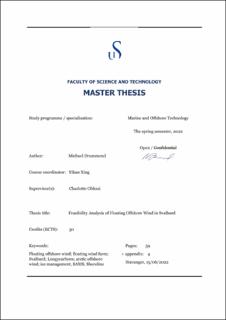| dc.description.abstract | Svalbard is a Norwegian island archipelago located far north in the Arctic with Longyearbyen its largest settlement. Fossil fuel in the form of diesel generators or coal power plants is still the primary energy source in all the settlements of Svalbard. In 2018, The Ministry of Petroleum and Energy (MPE) commissioned a study on the future energy supply options for Svalbard. This study did not explore offshore wind, and considered onshore turbines to have lower cost, with similar environmental consequences. Recently, policy has restricted the future development of onshore wind turbines as a result of local opposition and concern over sensitive bird populations. Floating offshore wind (FOW) could be considered as an alternative and the feasibility of such a project should be investigated further. As such, the purpose of this study is to investigate the feasibility of FOW in Svalbard. This was done through a case study, which is limited to the installation and operational feasibility of a semi-submersible FOW concept layout of six 12MW WINDMOOR units positioned 60km offshore from the entrance at Isfjorden. Reference literature on the subject is scarce, so typical arctic offshore engineering challenges are explored to aid the analysis.
Typical and extreme site conditions and challenges encountered with arctic offshore installations is of great interest to the case study. Of these challenges, sea ice was identified as a critical environmental condition for the installation and operation of offshore structures in the arctic. At the selected site however, due to the warmer and more favourable climate conditions on the west coast of Svalbard, sea ice is expected to be small and in low concentrations. The concept was then tested for the expected extreme ice conditions at the site using the Simulator for Arctic Marine Structures (SAMS) program. The results from the SAMS simulation that replicated adverse sea ice conditions on the FOW concept showed that sea ice would likely be a minor issue and not impact on the stability of the semi-submersible structure. This provides greater confidence that one of the major challenges in the arctic would not be a significant issue at the selected site. The threat from icebergs was also considered, which would need to be monitored and managed should the project progress.
A high-level installation downtime assessment was conducted using Shoreline, a simulation tool for the programming and optimisation of offshore wind construction projects. From the results of the simulation, weather conditions during summer are favourable for the delivery of the project and downtime due to waiting on weather would be limited. From a constructability perspective, the project is possible. The study showed that the FOW concept would be able to meet the energy needs of Longyearbyen. However, while FOW is feasible in Svalbard from an engineering perspective, a business case analysis should be conducted for the selection of the alternative energy system. It is likely that this project may be too costly for any funding to be secured in the immediate future. The cost is projected to decrease which could make this a more attractive option within the decade. The onshore assembly of FOW units combined with long distance towing operations has been achieved before in Norway for a similar scale project. The concept would also be dependent on the future environmental policy as well as conflicts with stakeholders in tourism, fishing, and shipping. More research is required to progress the FOW concept to development. The most critical information required would be a detailed cost estimate enabling a business case analysis to be conducted. A preliminary cost assessment however indicates that electricity costs from FOW would be competitive against other forms of energy. This would ultimately decide the fate of the project. Stakeholder engagement and an environmental impact assessment would also need to be conducted for the project. | |
